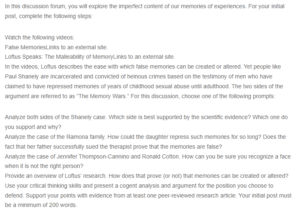The Jennifer Thompson and Ronald Cotton Case
The case of Thompson and Cotton reflects the process of what Robinson-Riegler & Robinson-Riegler (2012) describe as unconscious inference. Inference refers to a conclusion humans arrive at via evidence (Robinson-Riegler & Robinson-Riegler, 2012). Tracing its roots in the founders Hermann von Helmholtz, humans’ visual systems constantly make inferences regarding the outside world based on the data gathered and the evidence from past experiences (Robinson-Riegler & Robinson-Riegler, 2012). For instance, when Thompson was being assaulted, she made sure to study the face of the assailant as well as his demeanour and voice so that she could ensure he went to jail. Due to the kind of evidence she formed in her mind, she identified Cotton as her assailant even though he was not. This is because Thompson had already formed her inferences about the assailant in her mind, which was cemented the second time the real assailant and Cotton were presented before her. Since she had already formed inferences of evidence regarding Cotton, she declined that Bobby Poole was her assailant even after Bobby’s confession. In other words, the face of Cotton was already cemented in her mind, and therefore, she could not accept another person as her rapist. Polimeni (2018) argues that Thompson may have undergone unconscious transference, where she confused a person she saw in one situation with another in a different circumstance.
I think that Jennifer had an already formed image of Cotton in her mind, and the likelihood of picking Cotton as her rapist was high. Even on the lineup, she already knew who she would pick: Cotton. The outside environment also persuaded her to stay on Cotton as her assailant. For instance, the police officers did not bother asking her why she thought Cotton was her rapist; rather, they asked her if she was sure it was Cotton. I do not believe this was good enough evidence to convict Cotton. They could have asked why she was sure he was the one. No other connections to her attacker were made. Polimeni (2018) writes that key factors significantly influence the accuracy of the identification of a perpetrator, including the witness herself, events’ circumstances, and human mind fallibility. These are exactly the factors surrounding the Thompson and Cotton case. Polimeni (2018) adds that the human mind is malleable and fallible and that every time one reflects on a certain memory, it changes, even if it is a bit. Possibly, Thompson’s memory of her rapist may have changed not slightly but big time. Even in the second recognition, while she tried to recall her assailant, her mind filled in the gaps to complete her memories, as Polimeni (2018) argues.
References
Polimeni, K. M. (2018). New York on eyewitness identifications: progressive or regressive. Syracuse L. Rev., 68, 635.
Robinson-Riegler, G. & Robin-Riegler, B. (2012). Cognitive Psychology: Applying the Science of the Mind, Third Edition. Boston, MA: Pearson Education Inc.
ORDER A PLAGIARISM-FREE PAPER HERE
We’ll write everything from scratch
Question 
In this discussion forum, you will explore the imperfect content of our memories of experiences. For your initial post, complete the following steps:

The Jennifer Thompson and Ronald Cotton Case
Watch the following videos:
False MemoriesLinks to an external site.
Loftus Speaks: The Malleability of MemoryLinks to an external site.
In the videos, Loftus describes the ease with which false memories can be created or altered. Yet people like Paul Shanely are incarcerated and convicted of heinous crimes based on the testimony of men who have claimed to have repressed memories of years of childhood sexual abuse until adulthood. The two sides of the argument are referred to as “The Memory Wars.” For this discussion, choose one of the following prompts:
Analyze both sides of the Shanely case. Which side is best supported by the scientific evidence? Which one do you support and why?
Analyze the case of the Ramona family. How could the daughter repress such memories for so long? Does the fact that her father successfully sued the therapist prove that the memories are false?
Analyze the case of Jennifer Thompson-Cannino and Ronald Cotton. How can you be sure you recognize a face when it is not the right person?
Provide an overview of Loftus’ research. How does that prove (or not) that memories can be created or altered?
Use your critical thinking skills and present a cogent analysis and argument for the position you choose to defend. Support your points with evidence from at least one peer-reviewed research article. Your initial post must be a minimum of 200 words.
